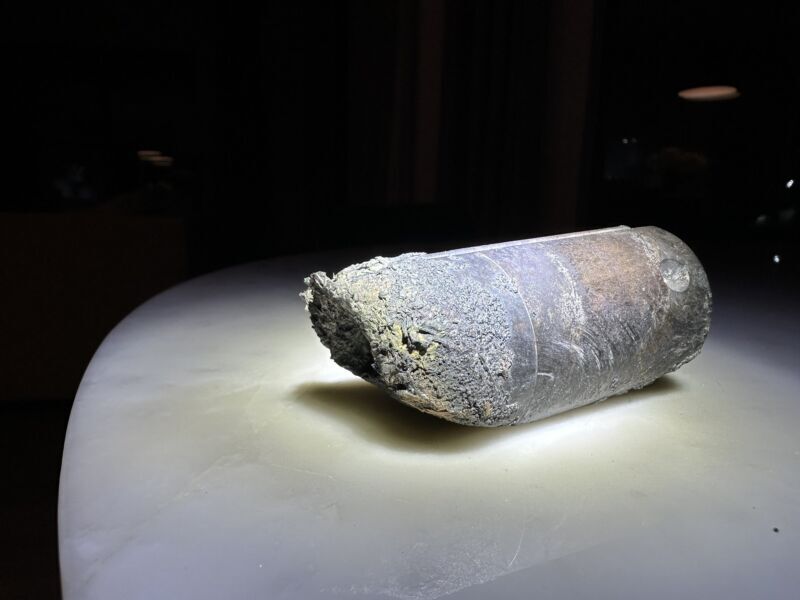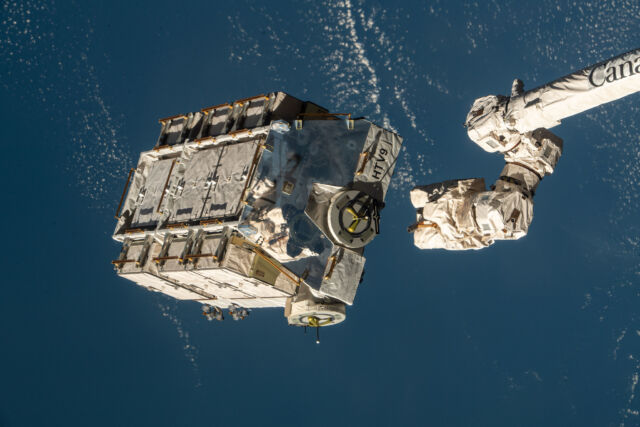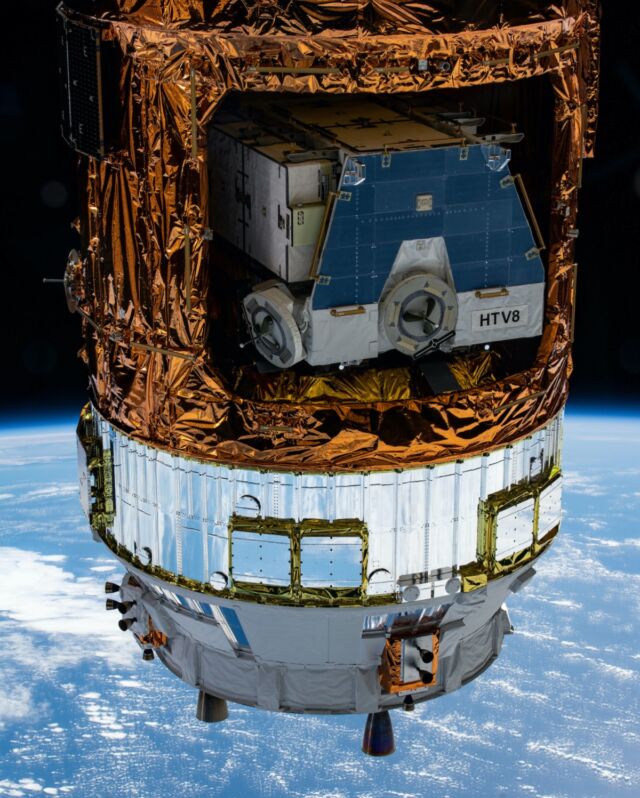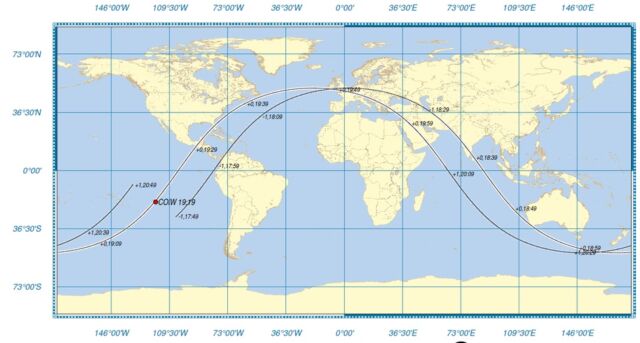3.04.2024
NASA collected the item to confirm whether it came from the International Space Station.

This cylindrical object, a few inches in size, fell through the roof of Alejandro Otero's home in Florida last month.
A few weeks ago, something from the heavens came crashing through the roof of Alejandro Otero's home, and NASA is on the case.
In all likelihood, this nearly 2-pound object came from the International Space Station. Otero said it tore through the roof and both floors of his two-story house in Naples, Florida.
Otero wasn't home at the time, but his son was there. A Nest home security camera captured the sound of the crash at 2:34 pm local time (19:34 UTC) on March 8. That's an important piece of information because it is a close match for the time—2:29 pm EST (19:29 UTC)—that US Space Command recorded the reentry of a piece of space debris from the space station. At that time, the object was on a path over the Gulf of Mexico, heading toward southwest Florida.
This space junk consisted of depleted batteries from the ISS, attached to a cargo pallet that was originally supposed to come back to Earth in a controlled manner. But a series of delays meant this cargo pallet missed its ride back to Earth, so NASA jettisoned the batteries from the space station in 2021 to head for an unguided reentry.
Otero's likely encounter with space debris was first reported by WINK News, the CBS affiliate for southwest Florida. Since then, NASA has recovered the debris from the homeowner, according to Josh Finch, an agency spokesperson.
Engineers at NASA's Kennedy Space Center will analyze the object "as soon as possible to determine its origin," Finch told Ars. "More information will be available once the analysis is complete."
Ars reported on this reentry when it happened on March 8, noting that most of the material from the batteries and the cargo carrier would have likely burned up as they plunged through the atmosphere. Temperatures would have reached several thousand degrees, vaporizing most of the material before it could reach the ground.
The entire pallet, including the nine disused batteries from the space station's power system, had a mass of more than 2.6 metric tons (5,800 pounds), according to NASA. Size-wise, it was about twice as tall as a standard kitchen refrigerator. It's important to note that objects of this mass, or larger, regularly fall to Earth on guided trajectories, but they're usually failed satellites or spent rocket stages left in orbit after completing their missions.
In a post on X, Otero said he is waiting for communication from "the responsible agencies" to resolve the cost of damages to his home.
If the object is owned by NASA, Otero or his insurance company could make a claim against the federal government under the Federal Tort Claims Act, according to Michelle Hanlon, executive director of the Center for Air and Space Law at the University of Mississippi.
"It gets more interesting if this material is discovered to be not originally from the United States," she told Ars. "If it is a human-made space object which was launched into space by another country, which caused damage on Earth, that country would be absolutely liable to the homeowner for the damage caused."
This could be an issue in this case. The batteries were owned by NASA, but they were attached to a pallet structure launched by Japan's space agency.
How this happened
At the time of the March 8 reentry, a NASA spokesperson at the Johnson Space Center in Houston said the space agency "conducted a thorough debris analysis assessment on the pallet and has determined it will harmlessly reenter the Earth’s atmosphere." This was, by far, the most massive object ever tossed overboard from the International Space Station. "We do not expect any portion to have survived reentry," NASA said.
However, research from other space experts did not match NASA's statement. The Aerospace Corporation, a federally funded research and development center, says a "general rule of thumb" is that 20 to 40 percent of the mass of a large object will reach the ground. The exact percentage depends on the design of the object, but these nickel-hydrogen batteries were made of metals with relatively high density.
Ahead of the reentry, the European Space Agency also acknowledged some fragments from the battery pallet may survive to the ground.

NASA typically doesn't want large chunks of space debris falling to Earth with an uncontrolled reentry. You can trace the reason this object came down unguided back to a Russian launch failure more than five years ago. NASA astronaut Nick Hague and Russian commander Alexey Ovchinin aborted their launch on a Soyuz spacecraft when their rocket failed shortly after liftoff.
One of Hague's jobs at the International Space Station would have been to go outside on spacewalks to help install a new set of lithium-ion batteries recently delivered by a Japanese HTV cargo ship. But Hague didn't reach the station in 2018, so NASA put off the spacewalks until a new team of astronauts arrived at the complex.
This interruption to the space station's carefully choreographed schedule threw off the entire multiyear plan for upgrading the batteries on the outpost's electrical system. Instead of putting the old batteries back into the HTV for a guided destructive reentry over the open ocean, NASA held onto the cargo pallet at the station when the HTV supply ship needed to depart.
Each of the subsequent HTV missions delivered more fresh batteries to the space station and then departed the complex with the cargo pallet and decommissioned batteries from the previous HTV mission. That was the case until there were no more HTVs to fly. Japan's last HTV spacecraft departed the ISS in 2020 with the cargo pallet and batteries from the prior flight, stranding the last battery pallet at the station.

The space station's other cargo vehicles—SpaceX's Dragon, Northrop Grumman's Cygnus, and the Russian Progress—can't accommodate the HTV cargo pallet.
So NASA decided to jettison the battery pallet using the space station's robotic arm in March 2021 in order to free up real estate on the lab. Without any propulsion of their own, the batteries were adrift in orbit for three years until aerodynamic drag finally pulled the pallet back into the atmosphere on March 8, almost exactly three years later.
It is notoriously difficult to predict where a piece of space junk will reenter the atmosphere. US Space Command precisely tracks tens of thousands of objects in Earth orbit, but the exact density of the upper atmosphere is still largely an unknown variable. Even a half-day before the reentry, US Space Command's estimate for when the battery pallet would fall to Earth had a window of uncertainty spanning six hours, enough time for the object to circle the planet four times.
And if you don't know when something will reenter the atmosphere, you can't predict where it will come down.
A rare event
If NASA confirms the projectile that fell through Otero's house last month came from the ISS, it would join a small handful of incidents when an object falling out of orbit damaged someone's property.
Earth is a big place. It's fairly common for someone to find a piece of fallen space junk in a field or washed up on a beach. But it is rare for a reentry to hit a structure or injure a person.
Falling space debris has never killed anyone. According to ESA, the annual risk of an individual human being injured by space debris is less than 1 in 100 billion.
But there are a few examples of damage. In 2003, a foot-long metal bracket from the doomed space shuttle Columbia smashed through the roof of a dentist's office in Texas. Fortunately for those who worked there, the Columbia accident happened on a Saturday when the office was closed.
An Oklahoma resident named Lottie Williams was struck in the shoulder by a lightweight piece of material in 1997 that experts linked to the reentry of the upper stage from a Delta II rocket. It was a glancing blow, and the air helped slow down the piece of debris, so she escaped injury. There was also an incident in 1969 when a fragment from a Soviet spacecraft reportedly hit a small Japanese ship near the coast of Siberia, injuring five people.
When a large Chinese Long March 5B rocket fell out of orbit in 2020, wreckage damaged a village in the Republic of Côte d'Ivoire.
The Long March 5B is a frequent offender of debris. Its design is unique in that the first stage of the Long March 5B actually accelerates to orbital velocity, rather than relying on an upper stage to put its payload into orbit, as most rockets do.
The Long March 5B's core stage has a mass of about 20 metric tons and measures around 100 feet (30 meters) long and 16 feet (5 meters) wide. An object that size could do a lot of damage if it fell to the ground in the wrong place. China never designed the Long March 5B to steer itself back into the atmosphere, so a few days after each launch, the booster comes down without control.
Four Long March 5Bs have been launched to date, with more flights planned in the coming years to launch Chinese Internet satellites and a Chinese astronomical observatory comparable in size to the Hubble Space Telescope. After a launch in 2022, villagers recovered debris from the Long March 5B after it fell in Borneo, although officials reported no damage.

One of the more famous incidents of damage from space debris was the 1978 reentry of Kosmos 954, a nuclear-powered Soviet military satellite, in remote northern Canada. The wreckage from Kosmos 954 didn't injure anyone or damage any homes, but Canada organized a cleanup effort to recover as much radioactive debris as possible to guard against environmental impacts. The Soviet Union paid Canada $3 million in Canadian dollars to settle the matter.
"Spacefaring nations must minimize the risks to people and property on Earth of re-entries of space objects and maximize transparency regarding those operations," NASA Administrator Bill Nelson said in a 2021 statement following one of the Long March 5B reentries.
SpaceX's Starlink Internet satellites, which make up most of the active spacecraft in orbit, are designed to burn up on reentry. In most cases, US and European launch companies design their missions to bring their rockets' upper stages back into the atmosphere over the ocean when their missions are done.
Most recently, SpaceX has designed trajectories for test flights of the Starship rocket out of concern about an uncontrolled reentry. Starship is the largest single object ever launched into space and could pose a significant risk—compared to most space debris—to people or property if it fell to Earth without any guidance.
For the first few Starship test flights, SpaceX has intentionally guided Starship on a trajectory that would bring it down over a remote stretch of ocean within an hour or two of launch rather than putting it into a stable orbit where it might stay for days or weeks. This ensures Starship can safely reenter the atmosphere until SpaceX can demonstrate an ability to deorbit the vehicle for a controlled reentry.
Quelle: arsTechnica
+++
Suspected space object crashes through roof of home in Naples, Florida
Alejandro Otero alleged the object crashed through his home in March.
An alleged space object has appeared to crash through the roof of a family home in Naples, Florida, leaving several questions and a damaged residence in its wake.
Last month, Jonathan McDowell, an astronomer at the Harvard–Smithsonian Center for Astrophysics, took to X, to share that an "equipment pallet" from space had reentered Earth's atmosphere, hypothesizing it would likely have reached Fort Myers, Florida.

"The EP-9 equipment pallet reentered at 1929 UTC over the Gulf of Mexico between Cancun and Cuba. This was with the previous prediction window but a little to the northeast of the 'most likely' part of the path. A couple minutes later reentry and it would have reached Ft Myers," McDowell wrote on March 8.
Alejandro Otero, a homeowner in Naples, Florida – about 40 miles south of Fort Myers – responded to McDowell on X and shared several photos of damage to his home, as well as a photo of the alleged space debris.

"Looks like one of those pieces missed Ft Myers and landed in my house in Naples," Otero wrote on March 15.
Otero said the apparent space object "tore through the roof" and went through two floors of his home, and that the object "almost hit my son."
Otero previously claimed he had reached out to NASA for a response but did not hear back. In a statement Tuesday, NASA said the agency "collected an item in cooperation with the homeowner, and will analyze the object at NASA’s Kennedy Space Center in Florida as soon as possible to determine its origin," adding, "More information will be available once the analysis is complete."

In an interview with WINK TV in Ft. Myers, Otero said he was on vacation when the incident took place but that his son was home and called him about the damage, saying, "Something ripped through the house and then made a big hole on the floor and on the ceiling."
"When we heard that, we were like, impossible, and then immediately I thought a meteorite," Otero told WINK.
Otero said the object weighs nearly two pounds and appears to be "cylindrical-shaped."

"It used to have a cylindrical shape, and you can tell by the shape of the top that it traveled in this direction through the atmosphere. Whatever you burned, created in this burn and melted the metal over in this direction," Otero told WINK.
Upon arrival to his home, Otero said he was "shaking" and that he's "super grateful that nobody got hurt."
“I was shaking. I was completely in disbelief," Otero told WINK. "What are the chances of something landing on my house with such force to cause so much damage?” he said, adding, “I’m super grateful that nobody got hurt.”
ABC News has reached out to Otero for a comment.
Quelle: ABC News
